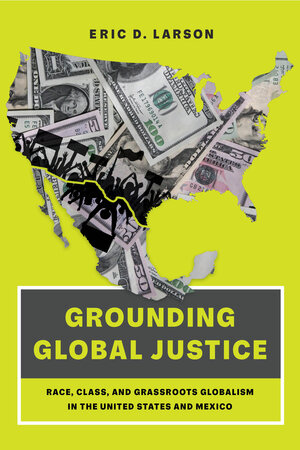The Book
Grounding Global Justice: Race, Class, and Grassroots Globalism in the United States and Mexico
The Author(s)
Eric D. Larson

Eric D. Larson’s Grounding Global Justice: Race, Class, and Grassroots Globalism in the United States and Mexico focuses mainly on three case studies of grassroots organizations and their tactics to educate the masses about the threats of corporate globalization. The book centers on two critical socio-political events at the turn of the twenty-first century, the 1999 Seattle and 2003 Cancun World Trade Organization (WTO) protests, to showcase the ideological and organizing principles of three organizations, the Unión Nacional de Organizaciones Regionales Campesinas Autónomas (UNORCA), Jobs with Justice, and the Consejo Indígena Popular de Oaxaca “Ricardo Flores Magón” (CIPO-RFM). Through these case studies, Larson explores the relationship between colonialism, capitalism, and global-justice movements.
Larson connects the histories of these organizations through a discussion of how the North American Free Trade Agreement (NAFTA) affected the socioeconomic realities of small farmers and factory workers across the US/Mexico border. Through a careful examination of leadership and membership structures, the book exposes the many ideological blindspots and biases of activists both in the US and Mexico when it comes to issues of race, ethnicity, and gender. Additionally, the book considers how political negotiations can lead grassroots organizations to deviate from their original stances (sometimes towards more inclusivity or social justice causes, and sometimes away from it).
The book’s strongest sections are those that focus on the Mexican organizations, UNORCA and CIPO-RFM. Larson makes a very detailed analysis of the two organizations’ membership, structures, positions on NAFTA, relations with the Mexican government, and participation in the 2003 Cancun WTO protests. Further, Larson makes a comprehensive comparison of how the organizations’ ideological leanings (populist vs anarchist, pragmatist vs radical) affected the way they related to indigenous populations and other marginalized groups in Mexico, as well as the fervor and originality of their activist tactics and positions regarding NAFTA and the WTO.
Although the book’s discussion of the Seattle protests and the organization Jobs with Justice is very thorough and covers many interesting aspects about the role –or absence of consideration– of race and colonialism among certain activist groups in the US, the book’s argument would have flowed much better had it only centered on the Mexican organizations. The chapters focused on activism in the US feel like the start of a different book about how certain American activist groups lack a global perspective regarding other people’s struggles throughout the world, rather than on the effects of free-market policies across the world, the main topic of this book.
Overall, Larson’s analysis is an important addition to the study of grassroots organizations and global activists’ networks. Further, the book’s centering on Mexico to discuss the effects of NAFTA serves as an important reminder of how capitalist policies focused on a Western vision of the world often obscure their effect on marginalized groups throughout the world.
About the Reviewer
Naida García-Crespo is an independent researcher with a PhD in English from the University of Illinois in Urbana Champaign. Her work has appeared in Film History, Early Popular Visual Culture, and CENTRO Journal, among other journals. She is the author of Early Puerto Rican Cinema and Nation Building (1897-1940): National Sentiments, Transnational Realities (Bucknell University Press, 2019).

0